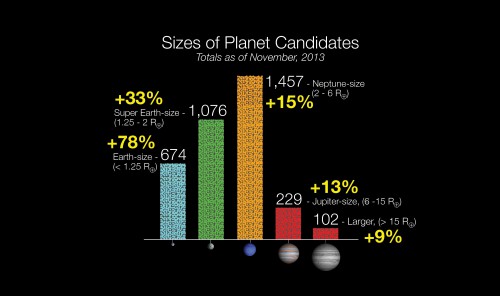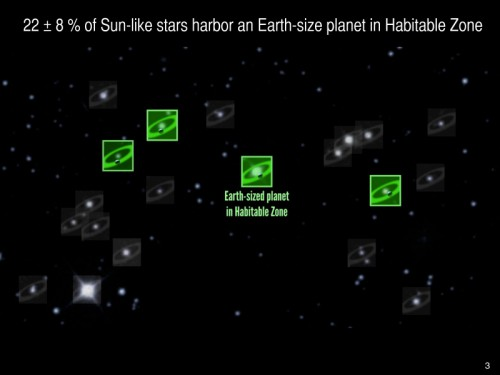
What a wonderful and amazing Scheme have we here of the magnificent Vastness of the Universe! So many Suns, so many Earths, and every one of them stock’d with so many Herbs, Trees and Animals, and adorn’d with so many Seas and Mountains! And how must our wonder and admiration be encreased when we consider the prodigious distance and multitude of the Stars?
— Christiaan Huygens, “Cosmotheoros”, 1698
Although the existence of planets outside our Solar System had been pondered since the time of the Ancient Greek civilisation, extrasolar planets remained a staple of science fiction and fantasy for most of human history. All this changed over 20 years ago, with the discovery of the first extrasolar planet around the pulsar PSR B1257+12. Ever since, the field of extrasolar planets has been one of the most flourishing and productive in astronomy, with new discoveries now coming at a regular basis. And this field of scientific study has been revolutionised in recent years by NASA’s Kepler space telescope.
Kepler was launched in March 2009. Its mission was a straight-forward one: to characterise how common Earth-sized planets were around other stars and to identify Earth-like planets inside the “habitable zone” of these stars. Although it can be argued that the conditions for habitability might be found in a broader range of environments, scientists nonetheless wanted to look for planets inside the so-called “Goldilocks” orbits, where conditions are just right for liquid water to exist on their surfaces—a key prerequisite for life as we know it. Kepler hunted for planets using the “transit method,” where the spacecraft constantly observed a certain small patch of the sky containing 150,000 stars, looking for a dimming in a star’s brightness that would indicate that a nearby planet was crossing in front of it.
And the results of the mission could be described as nothing short of spectacular. The space telescope has already identified 167 confirmed exoplanets as of date and thousands more of planetary candidates. Fullfiling the objectives of its mission, all the data releases made by the Kepler science team since the telescope’s launch, show the rate of discovery of Earth-like planets to be steadily increasing as time passes. That is to be expected, since Earth-type planets in long-period orbits are more difficult to detect and require many years of observations. Notable discoveries include the detection of the first-ever terrestrial exoplanet to be found, Kepler-10b, the first potentially habitable Earth-type planet around a Sun-like star, Kepler-22b, the first single-planet (Kepler-16b), and multi-planet (Kepler-47) systems around binary stars and two planetary systems both containing super-Earth-sized planets inside the systems’s “habitable zones,” (Kepler-62 and Kepler-69).
Although Kepler was sadly crippled by a malfunction last May in its second of four gyroscopes that were responsible for keeping it accurately pointed at the same patch of the sky, the amount of science data that yet await to be processed and analysed will keep astronomers occupied for many years to come.

This couldn’t be more evident than during the second Kepler Science Conference, held earlier this month at NASA’s Ames Research Center in Moffett Field, Calif., where scientists from all over the world gathered to discuss the telescope’s latest findings. These findings, presented on the first day of the Conference, showed that since the previous Kepler update back in January, there has been an increase of 29 percent in the detection of candidate planets, with 833 more added to the list, bringing the total to 3,538 planets that await confirmation by ground-based telescopes. More importantly, 78 percent of the newly discovered candidates are Earth-sized. It becomes evident as more data from Kepler is being processed, that Earth-like worlds may be even more common than previously thought. Past statistical studies have supported this notion, showing that every single star in the Milky Way must contain at least one planet.
At the same day that the newest Kepler findings were being presented, another study based on previous Kepler observations, was published by scientists working at the Keck Observatory in Hawaii. In the study, scientists showed that potentially habitable Earth-like worlds in the Galaxy may number in the billions. What the scientists did was to use Keck’s twin telescopes to obtain the spectra of only the Sun-like stars out of the total 150,000 Kepler was observing. That left them with approximately 42,000 stars. The scientists used sophisticated algorithms and software to weed out false positives and added artificial planetary signals in the Kepler data to check the software’s detection accuracy. In the end, the scientists came up with 603 candidate planets, out of 42,000 stars. From the candidates being discovered, ultimately 10 were found to be Earth-sized and lying inside their star’s habitable zone. This number may sound rather small, but we should keep in mind that the stars examined are such a tiny fraction of the Milky Way’s total, and that by using the transit method, only those planets can be detected whose orbits are edge-on to our line-of-sight. We can only speculate as to how many more are out there, awaiting discovery. Indeed, taking these factors into account, the scientists extrapolated that since the area of the sky Kepler was observing is a fairly typical one in the galaxy, at least 22 percent of all Sun-like stars in the Milky Way should harbor Earth-like planets. What this study implies cannot be overstated: there are hundreds of Sun-like stars within an 100-light-year radius of the Solar System and the nearest Earth-like planet could be located only a dozen light-years away.
Exoplanet discoveries may today seem routine, since new ones are being announced almost at a monthly basis. Yet this wasn’t always the case. We should always remember that, as mundane as they may seem to many, these discoveries represent one of the biggest triumphs of the human spirit.
Want to keep up-to-date with all things space? Be sure to “Like” AmericaSpace on Facebook and follow us on Twitter: @AmericaSpace




Leonidas: You have written a well-researched article on Kepler. The ever-increasing number of exoplanets will further reinforce the notion that life in the cosmos will eventually be discovered. Considering the Milky Way is but one of countless billions of galaxies, the statistics point to a commonality of planetary development and, by extension, the evolution of Earth-like, terrestrial planets “out there.” Conditions favorable to life? Of course!
Huygens was prophetic in his thinking and one wonders how he would react to the amazing findings that are happening at an exponential rate.
Thank you Tom! I was so thrilled and excited with all the new Kepler discoveries, that it was hard to contain my enthusiasm! Indeed, since the time of Copernicus, humanity has experienced a steady stream of revelations about its place in the Cosmos, revelations that everytime challenged our anthropo-centric notions like the Rare Earth Hypothesis. Everytime humanity thought that it was something unique and special, there came a new discovery to really put us in our place and put things into perspective. And in my opinion, those discoveries can’t come soon enough! I long for the day when Earth-like planets will be imaged for the first time! What a quantum leap that will be!
And Huygens had it right all along. I believe he would have been enthraled beyond words.
Leonidas, Once again Tom’s post is absolutely correct in every respect. Your article on Kepler is well-researched. It is also written as to be easily understood by one without a Ph.d in Astrophysics, and it is very interesting and engaging. Obviously Leonidas, you have put a great deal of effort into this article, and it has paid off. Your research and writing is clearly of the highest quality, and in keeping with what we have come to expect, and enjoy, on AmericaSpace (where I think you have found a home :-). But be forewarned my friend, now that you have proven that you are quite capable of such excellent work, you know what we will be expecting from you henceforth. When one gives another knowledge, that gift of knowledge, unlike material objects, is a gift that lasts a lifetime. Thank you for the gift of this article my friend.
When I consider the incredible discoveries that await us if we only have the will to use the technology we have, and develop that which we need, I feel like a parched, sun-baked man who has dragged himself across a scorching desert, and having reached an oasis, raises a life-saving handful of water to his cracked mouth, only to have it slapped away. I have heard disquieting rumors about fights over funding involving JWST versus Curiosity versus Cassini. The planetary science piece of the 0.48 of a penny of each budget dollar received by NASA seems like that handful of water.
(I don’t know how you do it, but I loved your Huygens quote – PERFECT!)
Karol, wonderful comments such as yours, are the ultimate reward for me. Thank you!
I don’t hold a Phd in Astrophysics either, but I strive to write articles that are very easy to be understood by everyone, the same way I’d like as a reader to read something that I could comprehend. I do that because I beleive that space is for everyone. No one should be left on the outiside, in this magnificent journey of exploration and discovery. At least that’s how I feel. And your comments are an indication that I’m on the right track, for which I couldn’t be happier 🙂
And I concur with your example and analogy. As to the rumors you’ve heard, there are some troubling news. You can read about it here and here. Although space observatories like the JWST, Hubble and Chandra are protected from budget cuts, things don’t look good for other planetary and astrophysics missions. In my opinion, this whole state of affairs is a travesty. I’d like to write an op-ed about it, but we’ll see.
Thank you for being such an active participant in the discussions and a friend 🙂